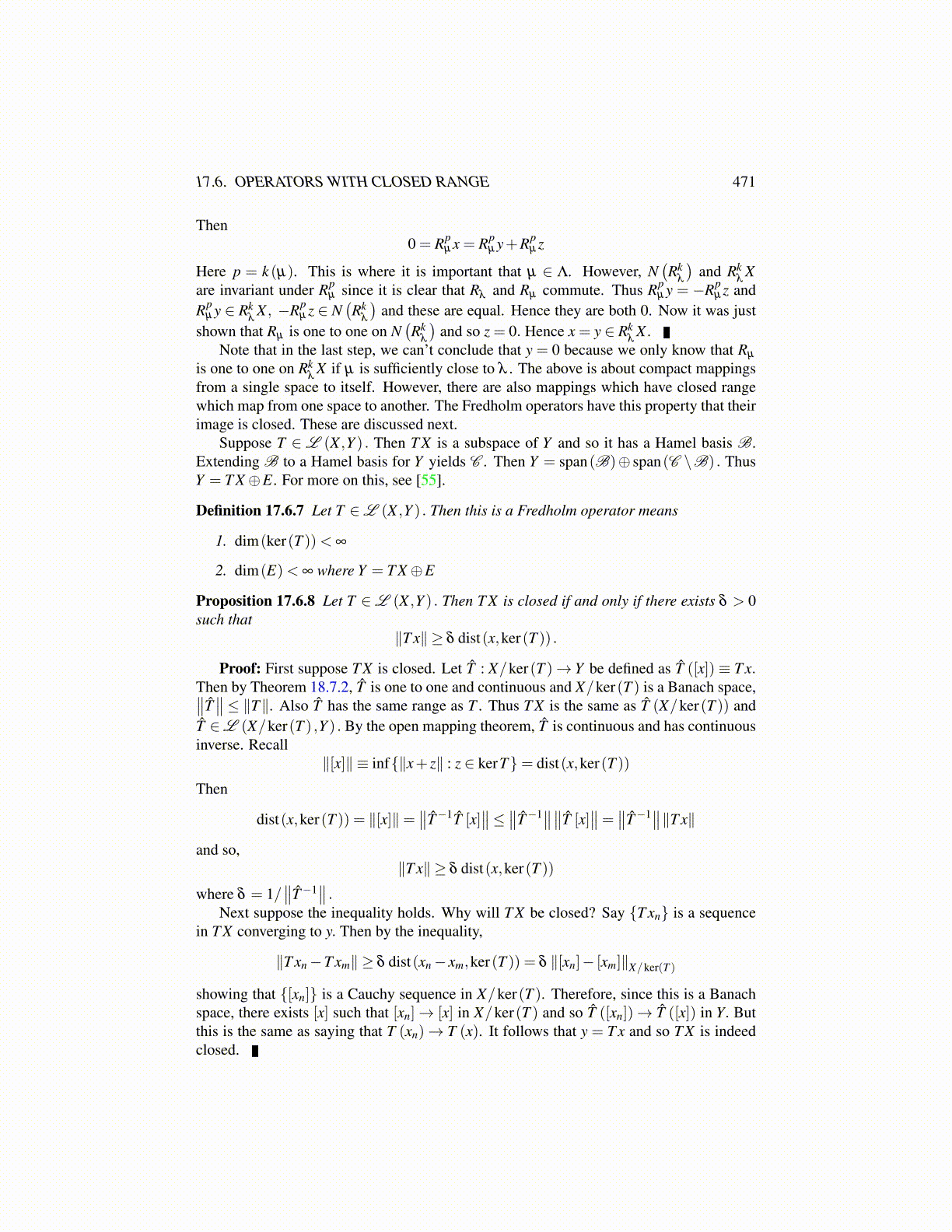
17.6. OPERATORS WITH CLOSED RANGE 471
Then0 = Rp
µ x = Rpµ y+Rp
µ z
Here p = k (µ). This is where it is important that µ ∈ Λ. However, N(Rk
λ
)and Rk
λX
are invariant under Rpµ since it is clear that Rλ and Rµ commute. Thus Rp
µ y = −Rpµ z and
Rpµ y ∈ Rk
λX , −Rp
µ z ∈ N(Rk
λ
)and these are equal. Hence they are both 0. Now it was just
shown that Rµ is one to one on N(Rk
λ
)and so z = 0. Hence x = y ∈ Rk
λX .
Note that in the last step, we can’t conclude that y = 0 because we only know that Rµ
is one to one on Rkλ
X if µ is sufficiently close to λ . The above is about compact mappingsfrom a single space to itself. However, there are also mappings which have closed rangewhich map from one space to another. The Fredholm operators have this property that theirimage is closed. These are discussed next.
Suppose T ∈L (X ,Y ) . Then T X is a subspace of Y and so it has a Hamel basis B.Extending B to a Hamel basis for Y yields C . Then Y = span(B)⊕ span(C \B) . ThusY = T X⊕E. For more on this, see [55].
Definition 17.6.7 Let T ∈L (X ,Y ) . Then this is a Fredholm operator means
1. dim(ker(T ))< ∞
2. dim(E)< ∞ where Y = T X⊕E
Proposition 17.6.8 Let T ∈L (X ,Y ) . Then T X is closed if and only if there exists δ > 0such that
∥T x∥ ≥ δ dist(x,ker(T )) .
Proof: First suppose T X is closed. Let T̂ : X/ker(T )→ Y be defined as T̂ ([x])≡ T x.Then by Theorem 18.7.2, T̂ is one to one and continuous and X/ker(T ) is a Banach space,∥∥T̂∥∥ ≤ ∥T∥. Also T̂ has the same range as T . Thus T X is the same as T̂ (X/ker(T )) and
T̂ ∈L (X/ker(T ) ,Y ) . By the open mapping theorem, T̂ is continuous and has continuousinverse. Recall
∥[x]∥ ≡ inf{∥x+ z∥ : z ∈ kerT}= dist(x,ker(T ))
Then
dist(x,ker(T )) = ∥[x]∥=∥∥T̂−1T̂ [x]
∥∥≤ ∥∥T̂−1∥∥∥∥T̂ [x]∥∥= ∥∥T̂−1∥∥∥T x∥
and so,∥T x∥ ≥ δ dist(x,ker(T ))
where δ = 1/∥∥T̂−1
∥∥ .Next suppose the inequality holds. Why will T X be closed? Say {T xn} is a sequence
in T X converging to y. Then by the inequality,
∥T xn−T xm∥ ≥ δ dist(xn− xm,ker(T )) = δ ∥[xn]− [xm]∥X/ker(T )
showing that {[xn]} is a Cauchy sequence in X/ker(T ). Therefore, since this is a Banachspace, there exists [x] such that [xn]→ [x] in X/ker(T ) and so T̂ ([xn])→ T̂ ([x]) in Y. Butthis is the same as saying that T (xn)→ T (x). It follows that y = T x and so T X is indeedclosed.